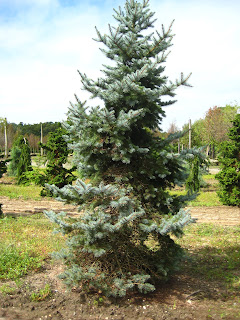The fact that landscape plants likely suffer more from moisture-related problems than any other problem (Harris et al. 2004)* shows us that water management in the garden is not only a complex issue, but also one that is critical to ensuring the health of our plants. We all know that having enough water is essential for plant survival and growth. But too much water can also kill or stunt a plant. Just like us, plant roots need oxygen for respiration, and if all the air space in soil is saturated with water, a plant can quickly drown. Finding the right balance between too little and too much water is challenging, but can be found through various approaches.
Photo: This Kousa Dogwood (Cornus kousa) in 2010 suffered from drought-stress after experiencing two weeks of no rain and 100+ degree temperatures. Repaving the parking lot during this time only made matters worse. Commack
Photo: This Kousa Dogwood (Cornus kousa) in 2010 suffered from drought-stress after experiencing two weeks of no rain and 100+ degree temperatures. Repaving the parking lot during this time only made matters worse. Commack
First, there’s the quick-and-dirty method. The Soil Moisture By Feel Test involves nothing more than a shovel and a willingness to get your hands dirty. Using the shovel to access the soil you want to test, take a small soil sample and roll or squeeze it into a ball in your hand. Soil moisture is just about right when you can form a ball and it crumbles when rubbed. If the soil won’t form a ball, it’s too dry to supply adequate water to plants. But if the ball will not crumble when rubbed, the soil is too wet. Unfortunately, this test is limited in its use because it won’t work for sandy soils.
Photo: Excessive rain throughout the 2011 growing season led to flooding at this nursery in Manorville. Too much water can lead to plant disease, decline, and death under the worst circumstances.
Photo: Excessive rain throughout the 2011 growing season led to flooding at this nursery in Manorville. Too much water can lead to plant disease, decline, and death under the worst circumstances.
Perhaps the most accurate way of determining how much to irrigate is to use a formula based on evapotranspiration, or the amount of water lost to evaporation by plants and soil. The leaves of plants have small openings which allow carbon dioxide to enter and water to exit by evaporation. Although about 95% of water absorbed by a plant is lost, this process, called transpiration, is important because it cools the leaves and helps with the absorption of water and nutrients by the roots and circulation of these throughout the plant. On hot sunny days with low humidity and high winds, evaoptranspiration and water loss will be the highest.
The formula method also factors in the vegetation type, microclimate, planting density, and species to arrive at a fairly accurate irrigation rate. Species can vary greatly in their water requirements and tolerance to drought and saturated soils. Be sure to consider the conditions under which a given plant evolved. Is the tree like Bald Cypress (Taxodium distichum), adapted to growing in the saturated soil of Southern swamplands? Or is the tree like Blue Atlas Cedar (Cedrus atlantica), adapted to the dry heat of the Mediterranean ? Answers to these questions will help determine the relative amount to water needed.
Photo: This Colorado Blue Spruce (Picea pungens), adapted to cool, dry areas of the west, developed Rhizosphaera Needlecast Disease (note the bare lower branches) when grown under Long Island's hot, wet, and humid growing conditions.
Photo: This Colorado Blue Spruce (Picea pungens), adapted to cool, dry areas of the west, developed Rhizosphaera Needlecast Disease (note the bare lower branches) when grown under Long Island's hot, wet, and humid growing conditions.
The last, and perhaps most practical, way of figuring out how much to water is to install a soil-moisture sensor. A tensiometer, which measures the force or tension that moisture is held by a soil, is a good choice for landscape settings. Each tensiometer costs about a hundred bucks and can be attached to an irrigation controller. If the soil moisture is below a certain level, the irrigation system will go off and water the plants until the desired moisture level is reached.
If you don’t like getting your hands dirty, if formulas frighten you, and if you are not inclined to purchase specialized equipment, then go by this simple rule of thumb for watering: make sure your plants get 1 – 2 inches of water (including rainfall) per week. (I bet you wish I’d said that at the beginning, right!) For recently planted trees, this equals about 15-20 gallons of water per week. During the summer months of June, July, and August it’s most important to provide supplemental water. By closely monitoring your plants, you’ll be able to get a sense of how much is the perfect amount of water.
*Harris, R.W., J.R. Clark, and N.P. Matheny. 2004. Arboriculture: Integrated Management of Landscape Trees, Shrubs, and Vines, 4th Edition. Prentice Hall: Upper Saddle River , NJ


